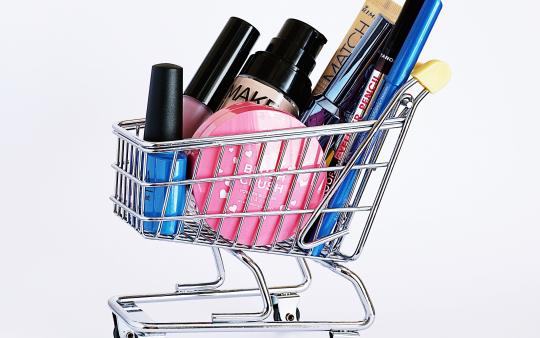This is the first in a series of three posts on the most toxic cosmetic ingredients and how to easily recognize them.
Do you feel overwhelmed when buying skincare and other cosmetic products for yourself and your family? It can make your head spin just looking at the selection and the ingredient list. Yet people are still trying to make informed, safe decisions. I see it every time I am at a store. There are people reading the labels everywhere! Without extensive training in chemistry/toxicology, though, it is becoming increasingly difficult to figure it all out. Here, I will attempt to take the guesswork out of it for you by showing you what to look for and some tricks to easily avoid toxic cosmetic ingredients.
3 simple rules for buying cosmetic products
1. If you cannot pronounce it, you should not put it on your skin!
You do not have to know exactly what acrylamide/sodium acryloyldimethyl taurate copolymer is to suspect that it is probably something you don’t want on your skin. As an aside, while doing my master’s degree in chemistry, I used to use acrylamide for my western blots — a procedure used to identify amino acids. I was instructed to always wear gloves while doing this, and there was a material safety data sheet outlining the dangers of this chemical. Yet, it can be included in cosmetic products because it is used at a low, purportedly acceptable level…..but is it really?! Regulations within the cosmetic industry in North America aren’t as straight-up as you’d think — being label-savvy is becoming more and more crucial.
2. An exception to rule #1….that weird Latin name.
Latin names are used to describe natural ingredients like oils and butters. Here is a crash course in Latin. Latin names are generally two words with the first one capitalized and the second one not. They are also often written in italics. They are an exception to rule #1 because cosmetic labeling requires the Latin name to be given. When you see Butyrospermum parkii (Shea Butter) or Theobroma cacao (Cocoa Butter), don’t worry, get excited! These are not toxic cosmetic ingredients. All botanical ingredients must be reported this way, so these products contain natural components that are good for the skin, even if you can’t pronounce them!
3. Avoid products that contain “fragrance.”
“Fragrance” is a loophole used by cosmetic manufacturers. In Canada, fragrance has been determined to be proprietary (secret recipe) information, meaning the company does not have to tell you what ingredients make up the fragrance. Parabens and phthalates are well known to be used in fragrance, but do not have to be declared as such in the product if they are listed as either “fragrance” or “parfum”. An easy way to avoid these exposures is to buy unscented products, use natural perfumes, or look for products that are scented with essential oils (those Latin names again!).
The “Dirty Dozen” (the first four)
The David Suzuki Foundation has compiled a list of twelve toxic cosmetic ingredients to avoid. Here is a short and not-so-sweet breakdown of the first four ingredients on David Suzuki’s “Dirty Dozen” list.
BHA and BHT
BHA (butylated hydroxyanisole) and BHT (butylated hydroxytoluene) are synthetic antioxidants used as preservative in moisturizers and other skincare products. BHA has been classified as a possible human carcinogen (cancer-causing agent) and is hypothesized to be a hormone disruptor. Choose products with natural antioxidants: Vitamin A, C, and E.
Coal Tar Dyes
P-phenylenediamine and colours labeled "CI" followed by a 5 digit number.
Coal tar dye is typically found in commercial hair dyes. It is a mixture of chemicals derived from petroleum. Coal tar is confirmed to have the ability to cause cancer in humans. There have been studies that show that women who use coal-tar-containing hair dye, especially for many years, have an increased risk of developing non-Hodgkin’s lymphoma (cancer of the lymph system). Be proactive and ask your hair stylist about the ingredients in their dyes at your next appointment.
DEA
DEA stands for diethanolamine (in cocamide DEA and lauramide DEA) and is used in personal care products to make them creamy, sudsy, or to make their pH more favorable. They’re primarily found in shampoos and cleansers. One easy way to avoid these ingredients is to get away from the mindset that something has to be super sudsy to be effective. A lot of the agents that are used to make products sudsy were developed during WWII as floor cleaners.
Phthalates
One of the most common toxic cosmetic ingredients, phthalates can be hidden under the label “fragrance”. Phthalates can also be used in creams and lotions as emulsifying agents (emulsifying agents are substances that facilitate the mixing of oil and water). When someone smells that “new car smell” they are smelling phthalates. Ways to reduce exposures to phthalates include: choosing products that are either unscented or scented with essential oils, as well as using products that contain a natural emulsifying agent such as “vegetable emulsifying wax”.
|
Phthalate name |
Found in |
|
Dibutyl phthalate (DBP) |
Deodorant, fragrance, hairspray |
|
diethyl phthalate (DEP) |
Deodorant, hairspray, hair mousse, hand and body lotions |
|
Butylbenzyl phthalate (BBzP) |
Fragrance and hairspray |
|
Diethylhexyl phthalate (DEHP) |
Fragrance |
|
Dimetyl phthalate (DMP) |
Deodorant |
I hope this will help make your next trip to buy personal care products easier! Just remember the 3 simple rules and check out the next 4 toxic skincare ingredients in Part 2 of this series.
Environmental Defense has produced a pocket guide to getting the toxins out of cosmetics that can be downloaded and kept in your wallet for easy reference while shopping.
Congratulations on making the first step towards safer cosmetics for yourself and your family!
*Originally published on June 4, 2016









